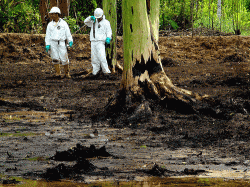
Chevron Continues Its Bad-Faith Legal Maneuvers To Attack Its Multi-Billion Dollar Liability in Ecuador
Second Circuit Denies Chevron Motion Promptly After Oil Giant Uses Panel to Release Documents in Desperate Attempt to Taint Eco-Disaster Lawsuit
Amazon Defense Coalition
New York, New York (December 22, 2010) Bad-faith legal maneuvering by Chevron has led to the improper public disclosure of hundreds of pages of private communications by and between attorneys representing the Ecuadorians suing Chevron for contamination, said one of the attorneys.
Last week Chevron filed a “naked, bad faith” motion before the Second Circuit Court of Appeals to expand its argument before the appeals court, which promptly denied the request but not before two legal affairs reporters wrote about the communications and posted them on their publications’ web sites.
“Knowing the appeals court would deny its motion, Chevron engaged in a naked, bad-faith attempt to use an improper court filing to taint the plaintiffs before the public. The Second Circuit promptly and properly denied the motion,” said Ilann Maazel, one of the plaintiffs’ attorneys. Maazel said the appeals court even ruled before the plaintiffs filed an objection to the motion.
Chevron’s attorneys at the law firm Gibson Dunn have portrayed plaintiff actions related to the criminal indictment of two Chevron lawyers in Ecuador as improper. During the trial, the plaintiffs turned over to an Ecuadorian prosecutor test results that revealed illegal levels of contamination at oil sites allegedly remediated by Chevron.
“We turned over evidence of a crime. It should come as no surprise that the perpetrator of the crime would complain,” said Karen Hinton, spokesperson for the Ecuadorians suing Chevron.
The remediation is the heart of Chevron’s defense in the civil lawsuit over the contamination. The Ecuadorian prosecutors indicted the Chevron lawyers and 12 former Ecuadorian government officials for lying about the results of the purported remediation. Even a valid remediation agreement is not relevant to the Ecuadorians’ lawsuit because it released Chevron only from government claims, not individual claims.
“Chevron’s attorneys at Gibson Dunn have a history of distorting facts, twisting comments and filing frivolous charges against their opponents. Anyone who has watched the law firm closely should not be surprised by this latest abuse of the legal system.”
Last year Gibson Dunn filed a malicious prosecution suit against an attorney who once represented the Ecuadorian plaintiffs in the contamination lawsuit. In May a California federal court dismissed virtually all of Chevron’s legal claims against the attorney, ruling that the oil giant could not substantiate its claims and that they were meritless. The judge order Chevron to pay legal costs for the attorney.
In November, Gibson Dunn lost another legal battle in a separate case that the law firm has compared to the Chevron litigation. A California county judge ruled that Gibson Dunn’s defamation lawsuit filed on behalf of its client Dole Food Co. tried to stifle the free speech of a Swedish filmmaker, who made a documentary about how Dole harmed workers on its Nicaraguan banana plantations. He ordered Dole to pay the filmmaker $200,000 in legal fees and costs as punishment.
Three of Chevron’s own lawyers have been sanctioned in Ecuador’s court system. Alberto Racines and Diego Larrea, both of whom have worked on Chevron’s legal team in Ecuador since the trial against Chevron began in 2003, were fined approximately $1,600 by Judge Nicolas Zambrano for repeatedly filing the same motions to delay the seven-year case.
In 2009, a third Chevron lawyer in Ecuador – Patricio Campuzano — was sanctioned for the same reason.
Hinton said the Chevron’s charges against the plaintiffs were simply a “sideshow” to distract from the real fraud in the case, the intentional contamination of the soil and water in the rainforest.
“Chevron’s accusations have nothing to do with the underlying facts of the lawsuit and the overwhelming evidence of its culpability in the world’s largest oil contamination disaster. There are over 64,000 samples of soil and water of which the vast majority reveals toxic, illegal levels of contamination. This is what the case is about, and the rest is just a sideshow to distract attention from Chevron’s fraud in the rain forest,” said Hinton.
Dozens of indigenous and farmer communities in Ecuador are suing the oil giant for deliberately dumping billions of gallons of toxic waste into Ecuador’s Amazon region when it operated a large oil concession from 1964 to 1990.
The contamination – which includes more than 900 abandoned toxic waste pits — has plunged the region into a public health crisis that threatens thousands of people with cancer and other oil-related diseases, according to evidence before the court.
